Modeling Power GaN-HEMTs Using Standard MOSFET Equations and Parameters in SPICE
Abstract
:1. Introduction
- Selection of relevant equations from the quite complex set of equations comprising the MOSFET LEVEL 3 model in SPICE.
- Development of a verified method to extract the initial values of all SPICE parameters in the selected equations, which is necessary to enable proper nonlinear fitting to measured characteristics of an arbitrary GaN-HEMT.
2. GaN Structure
3. Selection of Static Equations and Parameter Extraction
3.1. Selection of SPICE Equations
3.2. Methods for Extraction of Initial Values of the Selected Parameters
3.2.1. Extraction of KP, and Vto
3.2.2. Extraction of Rs, and Rd
3.2.3. Typical Initial Values for Gamma, Phi, Theta, and NFS
3.3. Non-Linear Fitting
4. Experimental Verification of the Static Characteristics
5. Modeling Dynamic Characteristics and Experimental Verification
6. Model Validation by LTSpice Simulation
7. Conclusions
Author Contributions
Funding
Data Availability Statement
Acknowledgments
Conflicts of Interest
Appendix A
Appendix B
References
- Mantooth, H.A.; Peng, K.; Santi, E.; Hudgins, J.L. Modeling of Wide Bandgap Power Semiconductor Devices—Part I. IEEE Trans. Electron Devices 2015, 62, 423–433. [Google Scholar] [CrossRef]
- Endruschat, A.; Novak, C.; Gerstner, H.; Heckel, T.; Joffe, C.; März, M. A Universal SPICE Field-Effect Transistor Model Applied on SiC and GaN Transistors. IEEE Trans. Power Electron. 2019, 34, 9131–9145. [Google Scholar] [CrossRef]
- Santi, E.; Peng, K.; Mantooth, H.A.; Hudgins, J.L. Modeling of Wide-Bandgap Power Semiconductor Devices—Part II. IEEE Trans. Electron Devices 2015, 62, 434–444. [Google Scholar] [CrossRef]
- Li, H.; Zhao, X.; Su, W.; Sun, K.; You, X.; Zheng, T.Q. Nonsegmented PSpice Circuit Model of GaN HEMT With Simulation Convergence Consideration. IEEE Trans. Ind. Electron. 2017, 64, 8992–9000. [Google Scholar] [CrossRef]
- Strauss, S.; Erlebach, A.; Cilento, T.; Marcon, D.; Stoffels, S.; Bakeroot, B. TCAD methodology for simulation of GaN-HEMT power devices. In Proceedings of the IEEE 26th International Symposium on Power Semiconductor Devices & IC’s (ISPSD), Waikoloa, HI, USA, 15–19 June 2014; pp. 257–260. [Google Scholar] [CrossRef]
- Huang, H.; Liang, Y.C.; Samudra, G.S. Theoretical calculation and efficient simulations of power semiconductor AlGaN/GaN HEMTs. In Proceedings of the IEEE International Conference on Electron Devices and Solid State Circuit (EDSSC), Bangkok, Thailand, 3–5 December 2012; pp. 1–4. [Google Scholar] [CrossRef]
- Waldron, J.; Chow, T.P. Physics-based analytical model for high-voltage bidirectional GaN transistors using lateral GaN power HEMT. In Proceedings of the 25th International Symposium on Power Semiconductor Devices & IC’s (ISPSD), Kanazawa, Japan, 26–30 May 2013; pp. 213–216. [Google Scholar] [CrossRef]
- Syamal, B.; Zhou, X.; Chiah, S.B.; Jesudas, A.M.; Arulkumaran, S.; Ng, G.I. A Comprehensive Compact Model for GaN HEMTs, Including Quasi-Steady-State and Transient Trap-Charge Effects. IEEE Trans. Electron Devices 2016, 63, 1478–1485. [Google Scholar] [CrossRef]
- Li, M.; Wang, Y. 2-d analytical model for current -voltage characteristics and transconductance of algan/gan modfets. IEEE Trans. Electron Devices 2008, 55, 261–267. [Google Scholar] [CrossRef]
- Krantia, A.; Haldarb, S.; Gupta, R.S. An accurate charge control model for spontaneous and piezoelectric polarization dependent two-dimensional electron gas sheet charge density of lattice-mismatched algan/GaN hemts. Solid State Electron. 2002, 46, 621–630. [Google Scholar] [CrossRef]
- Yu, T.-H.; Brennan, K.F. Theoretical study of a GaN-AlGaN high electron mobility transistor including a nonlinear polarization model. IEEE Trans. Electron Devices 2003, 50, 315–323. [Google Scholar] [CrossRef]
- Shah, K.; Shenai, K. Simple and Accurate Circuit Simulation Model for Gallium Nitride Power Transistors. IEEE Trans. Electron Devices 2012, 59, 2735–2741. [Google Scholar] [CrossRef]
- Aghdam, G.H. Model characterization and performance evaluation of GaN FET in DC-DC POL regulators. In Proceedings of the 2015 IEEE International Telecommunications Energy Conference (INTELEC), Osaka, Japan, 18–22 October 2015; pp. 1–4. [Google Scholar] [CrossRef]
- Huang, X.; Li, Q.; Liu, Z.; Lee, F.C. Analytical loss model of high voltage GaN hemtin cascode configuration. IEEE Trans. Power Electron. 2014, 29, 2208–2219. [Google Scholar] [CrossRef]
- DasGupta, N.; DasGupta, A. A new SPICE MOSFET Level 3-like model of HEMT’s for circuit simulation. IEEE Trans. Electron Devices 1998, 45, 1494–1500. [Google Scholar] [CrossRef]
- Peng, K.; Eskandari, S.; Santi, E. Characterization and Modeling of a Gallium Nitride Power HEMT. IEEE Trans. Ind. Appl. 2016, 52, 4965–4975. [Google Scholar] [CrossRef]
- Bouchour, A.M.; Dherbécourt, P.; Echeverri, A.; Oualkadi, A.E.; Latry, O. Modeling of Power GaN HEMT for Switching Circuits Applications Using Levenberg-Marquardt Algorithm. In Proceedings of the International Symposium on Advanced Electrical and Communication Technologies (ISAECT), Rabat, Morocco, 21–23 November 2018; pp. 1–6. [Google Scholar] [CrossRef]
- Xie, R.; Wang, H.; Tang, G.; Yang, X.; Chen, K.J. An analytical model for false turn-on evaluation of high-voltage enhancement-mode GaN transistor in bridge-leg configuration. IEEE Trans. Power Electron. 2016, 32, 6416–6433. [Google Scholar] [CrossRef]
- Hari, N.; Ramasamy, S.; Ahsan, M.; Haider, J.; Rodrigues, E.M.G. An RF Approach to Modelling Gallium Nitride Power Devices Using Parasitic Extraction. Electronics 2020, 9, 2007. [Google Scholar] [CrossRef]
- Islam, S.S.; Anwar, A.F.M. SPICE model of AlGaN/GaN HEMTs and simulation of VCO and power amplifier. In Proceedings of the IEEE Lester Eastman Conference on High Performance Devices, Troy, NY, USA, 4–6 August 2004; pp. 229–235. [Google Scholar] [CrossRef]
- Zeltser, I.; Ben-Yaakov, S. On SPICE Simulation of Voltage-Dependent Capacitors. IEEE Trans. Power Electron. 2018, 33, 3703–3710. [Google Scholar] [CrossRef]
- Colino, S.; Beach, R. Fundamentals of Gallium Nitride Power Transistors; Efficient Power Conversion Corp.: El Segundo, CA, USA, 2009; Application Note. [Google Scholar]
- Dimitrijev, S. MOSFET. Principles of Semiconductor Devices, 2nd ed.; Oxford University Press: New York, NY, USA, 2012; pp. 312–316. [Google Scholar]
- GaN Systems. Available online: https://gansystems.com/wp-content/uploads/2018/05/GN008-GaN_Switching_Loss_Simulation_LTspice_20180523.pdf (accessed on 1 October 2020).
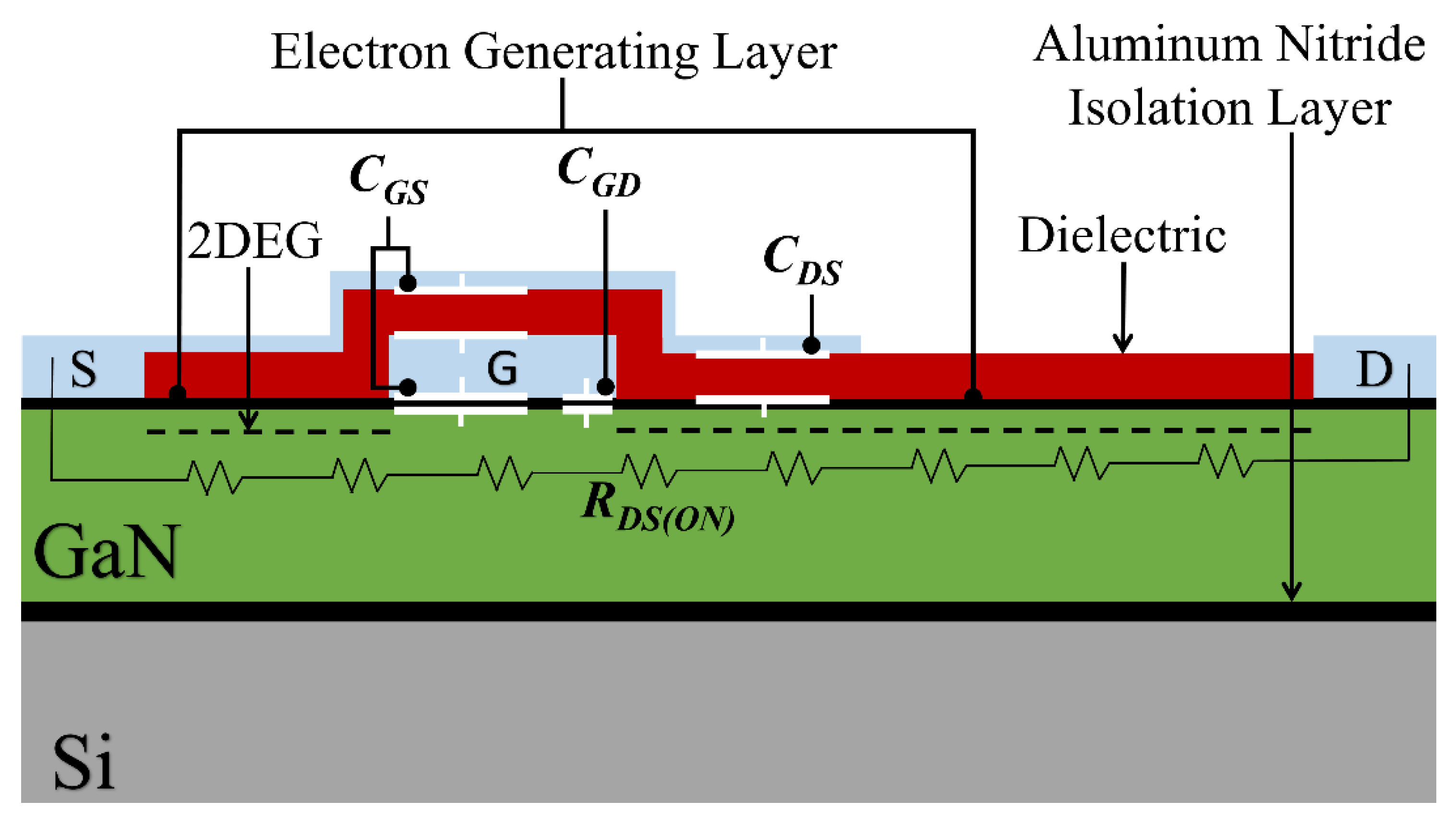
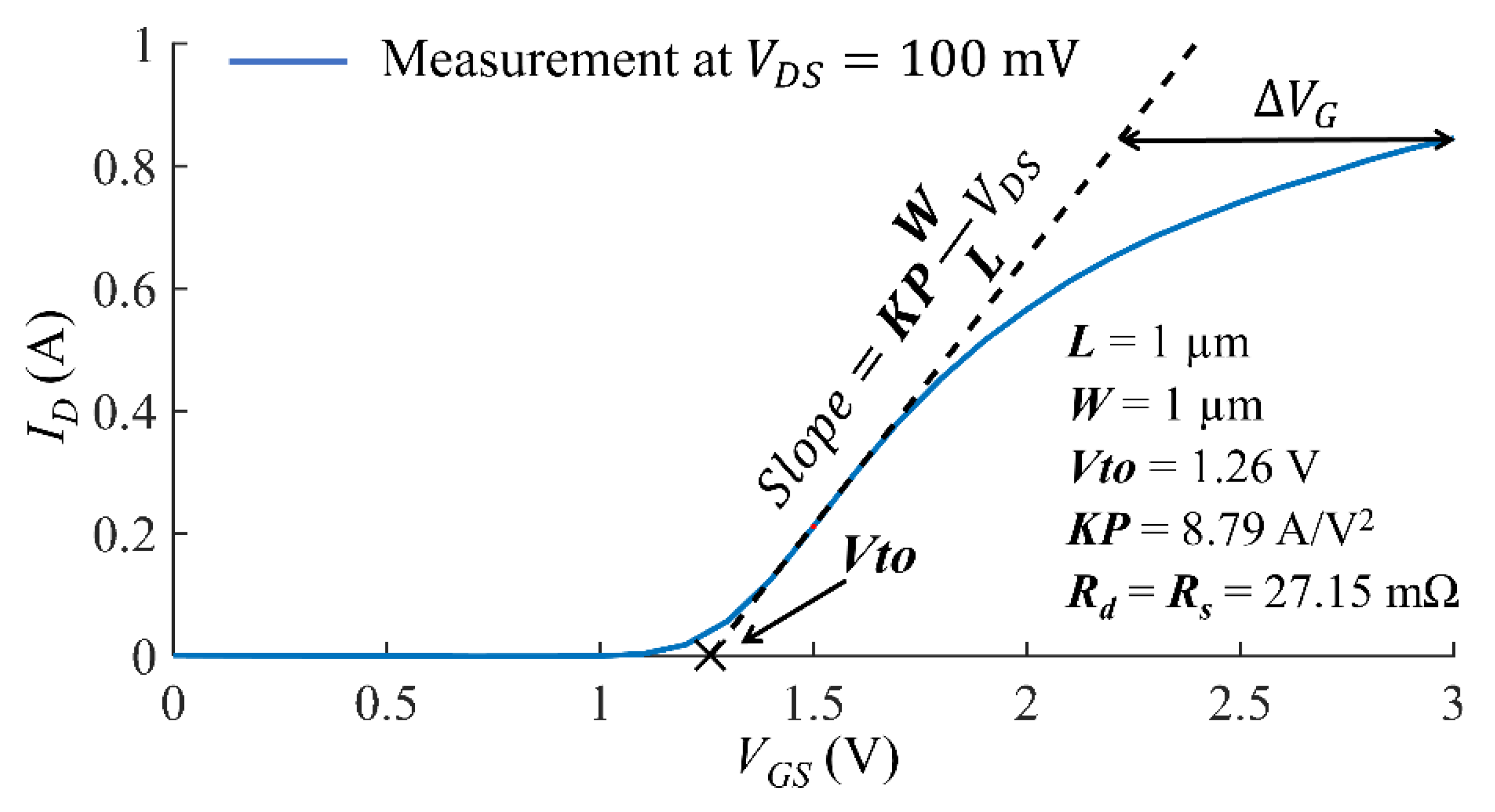
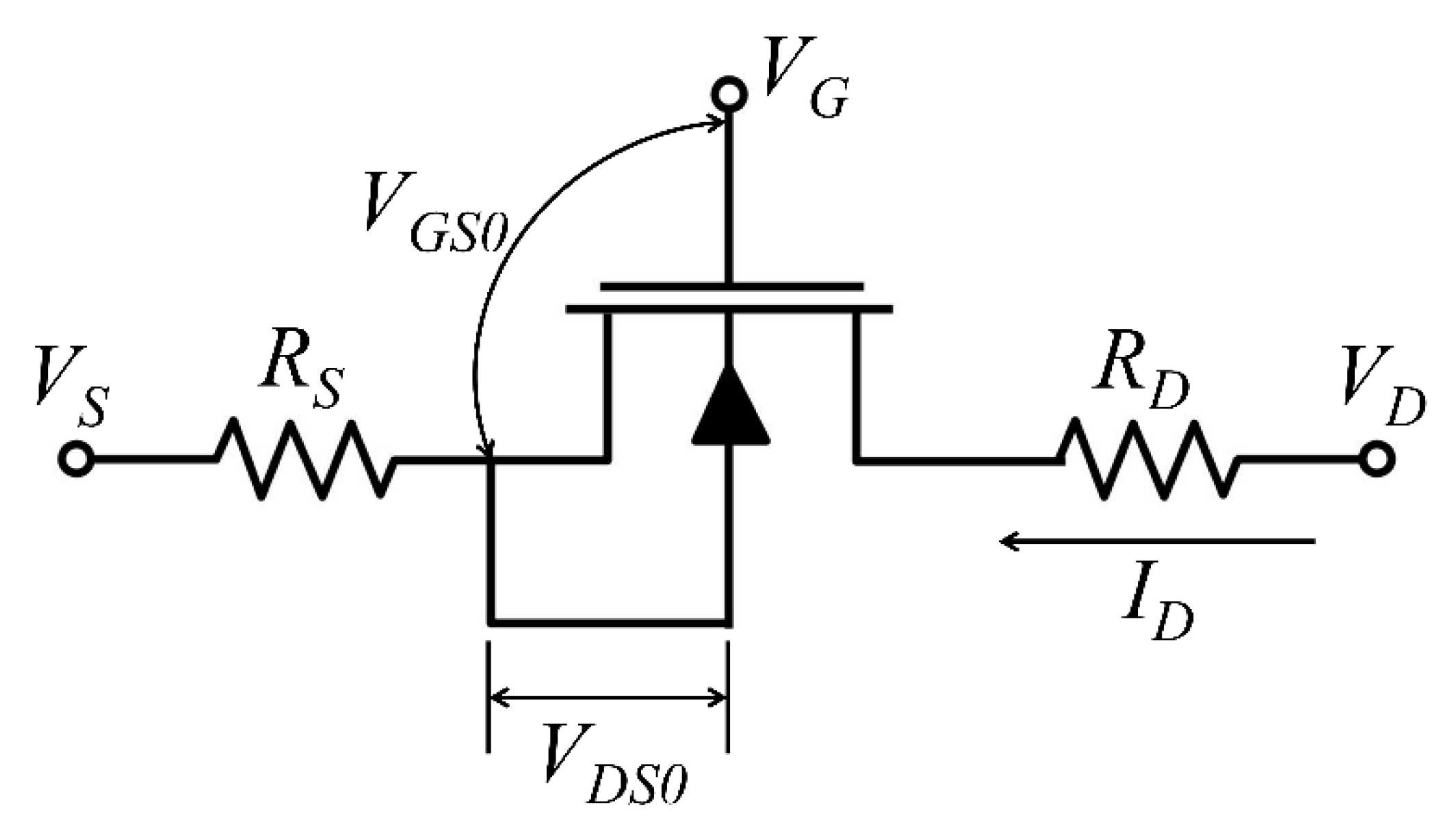
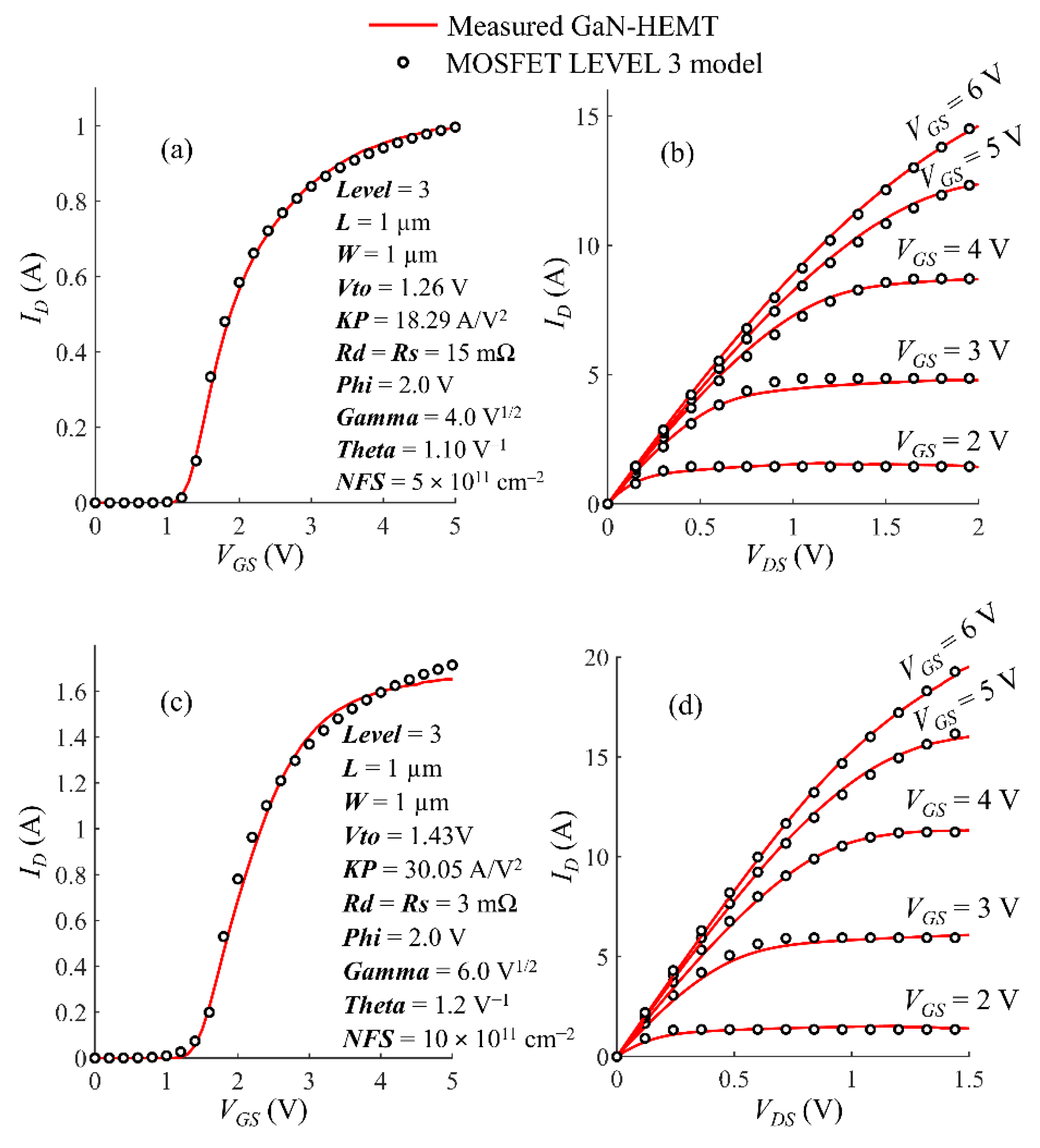
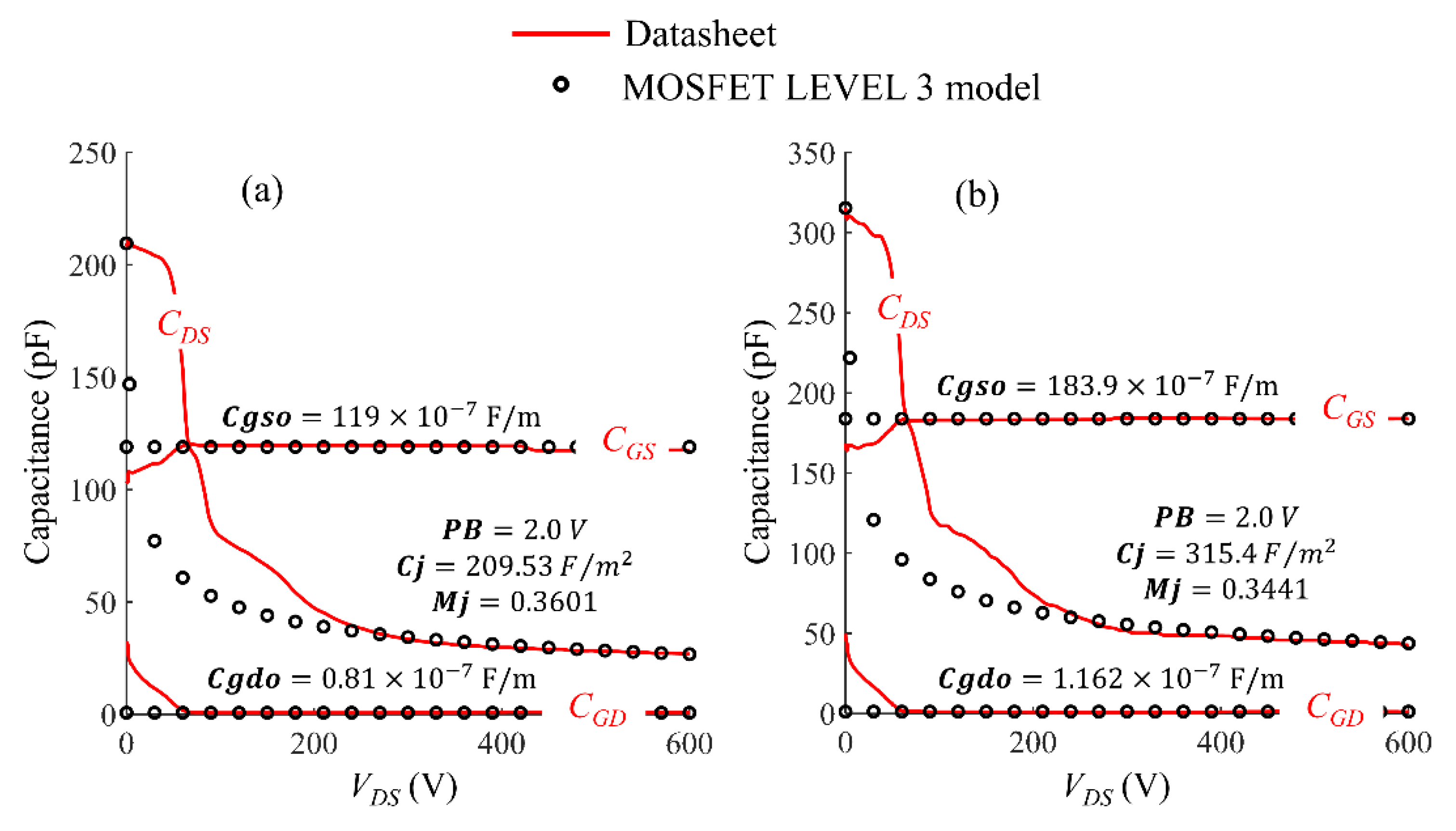
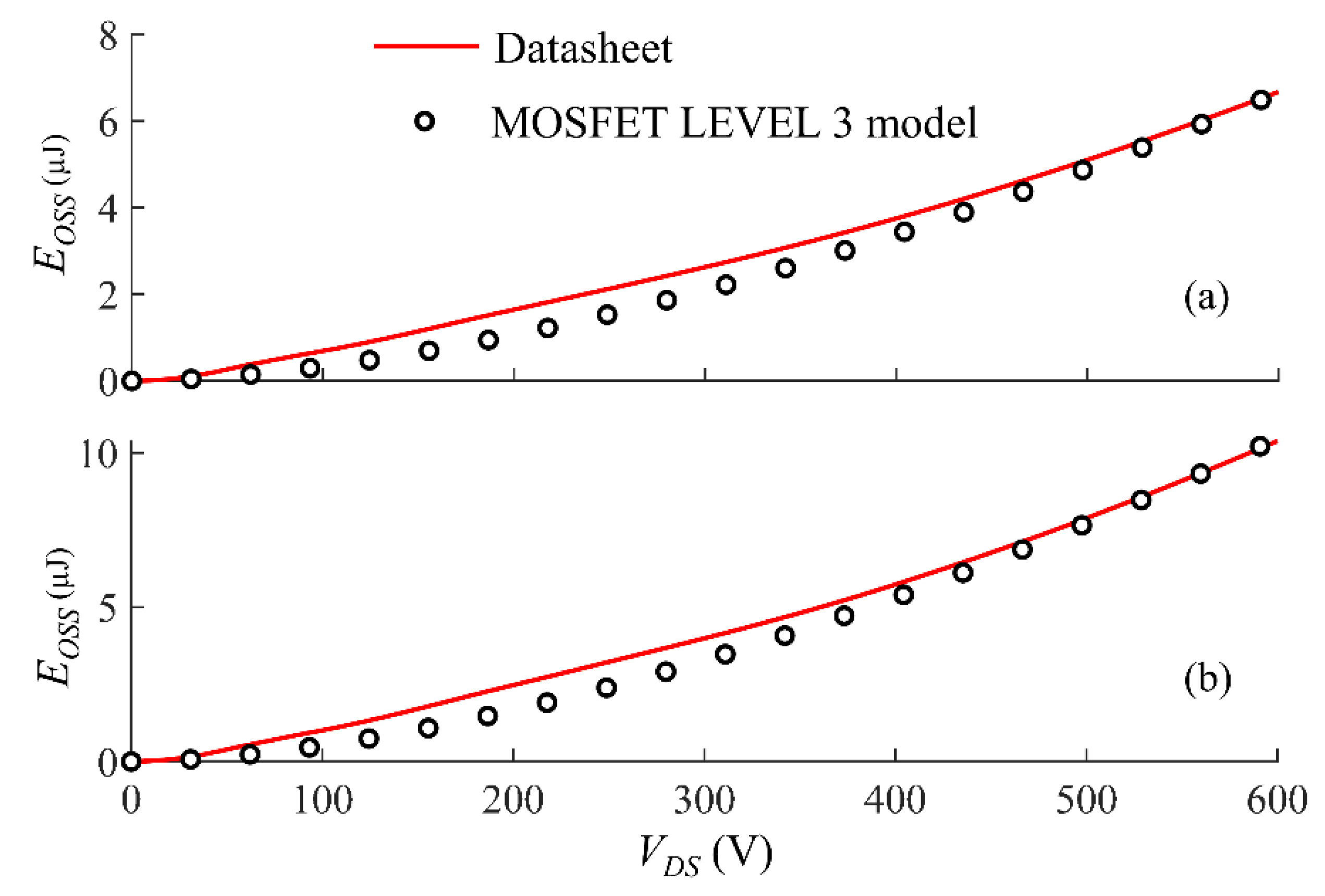
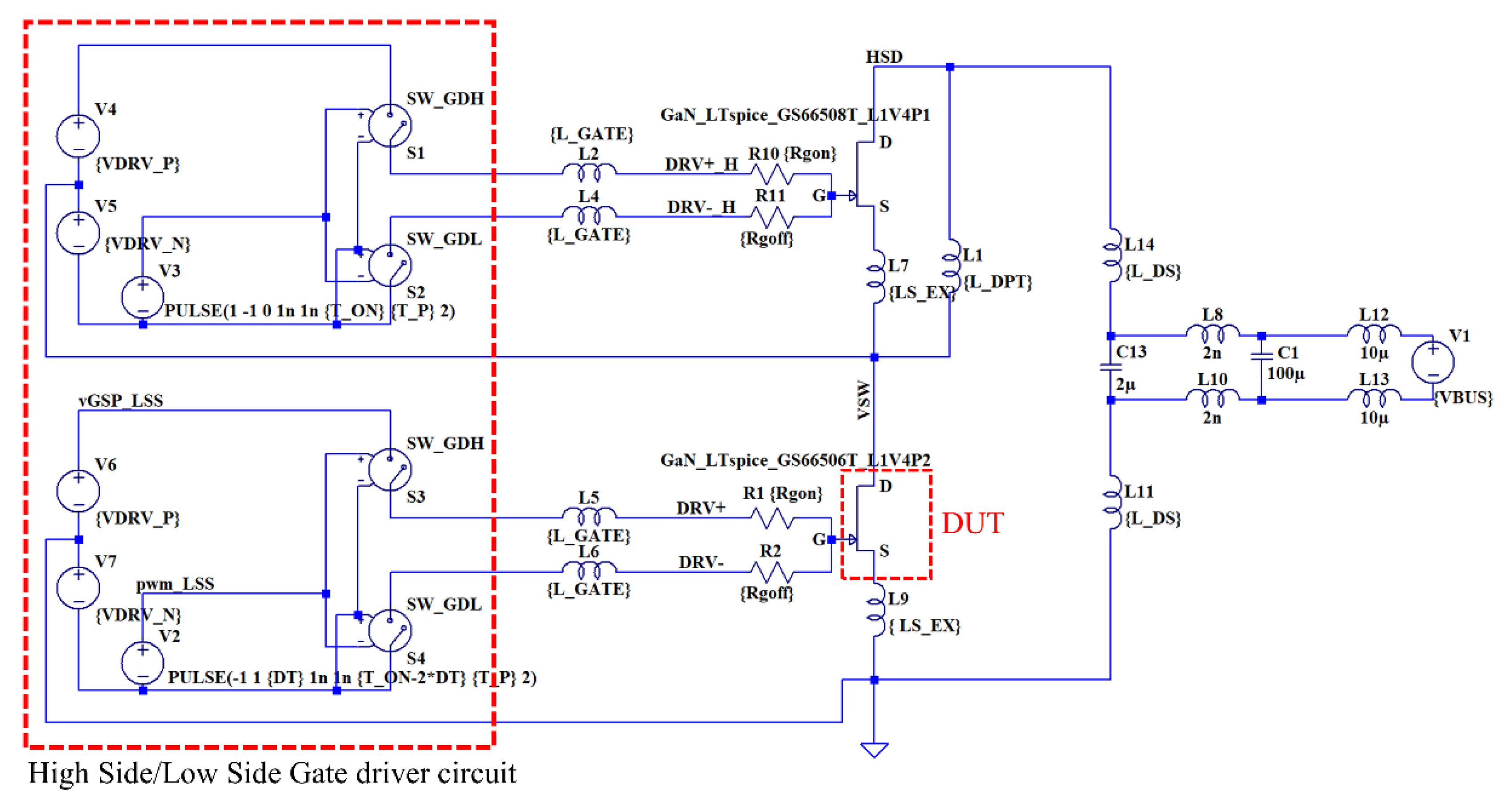
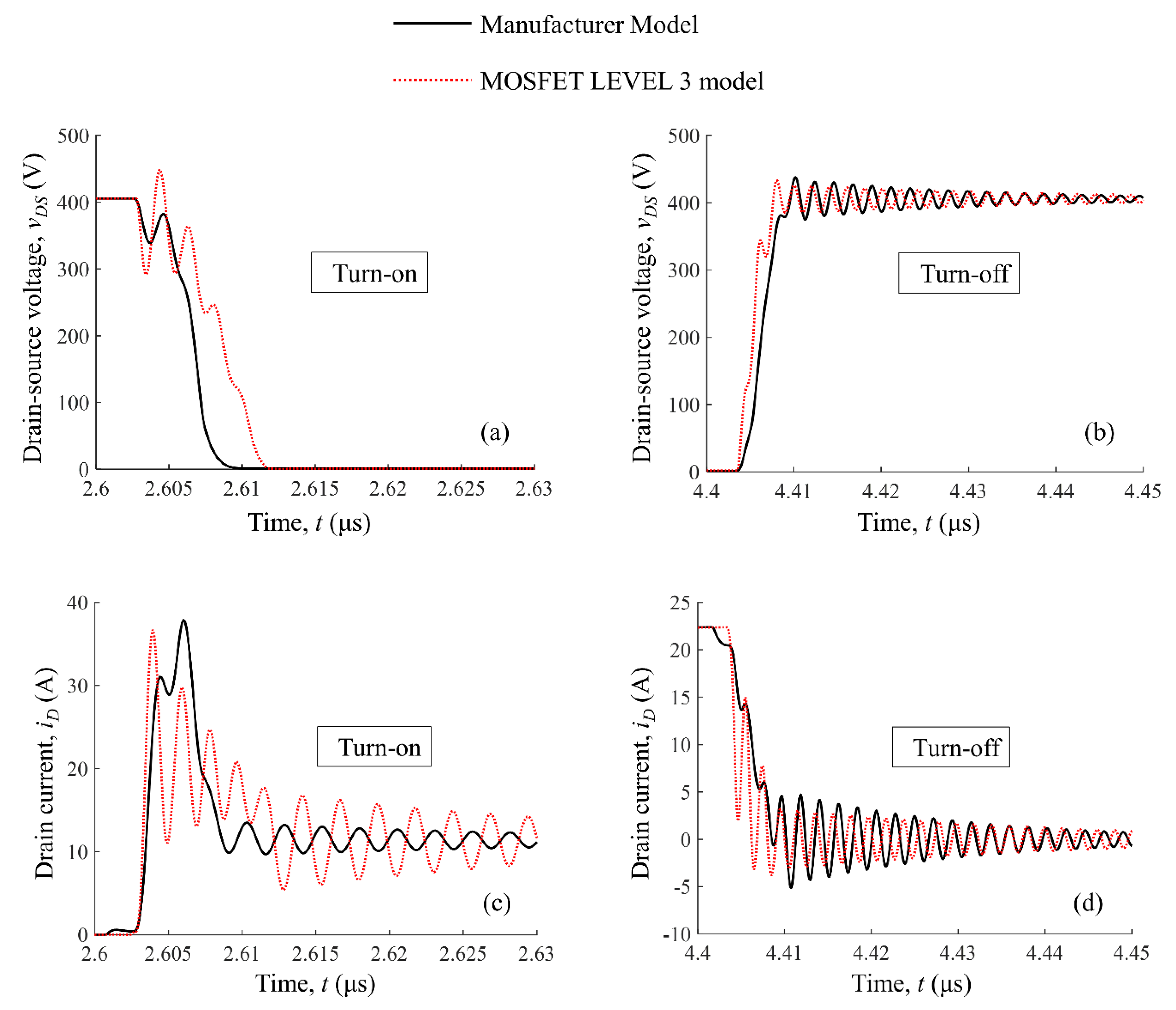
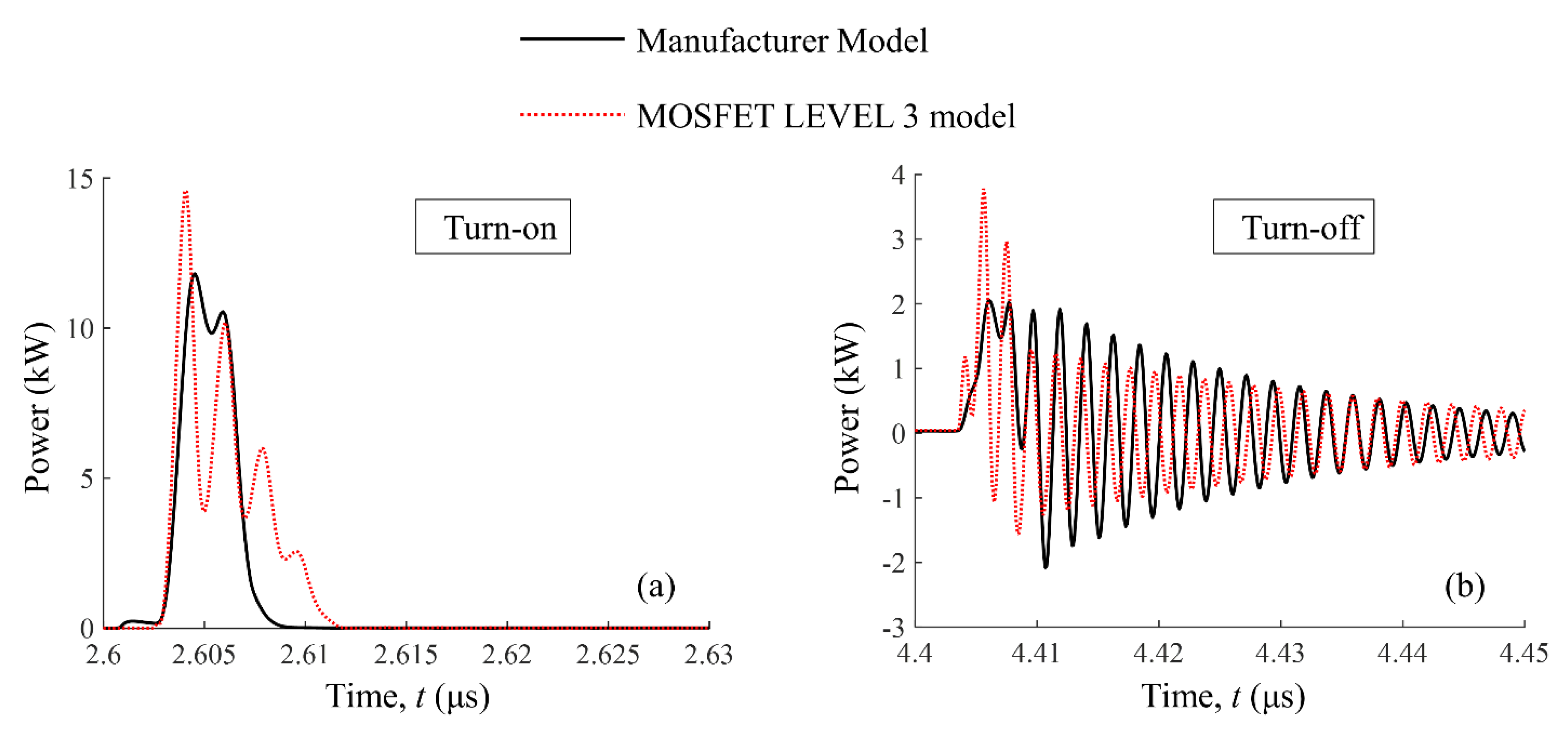
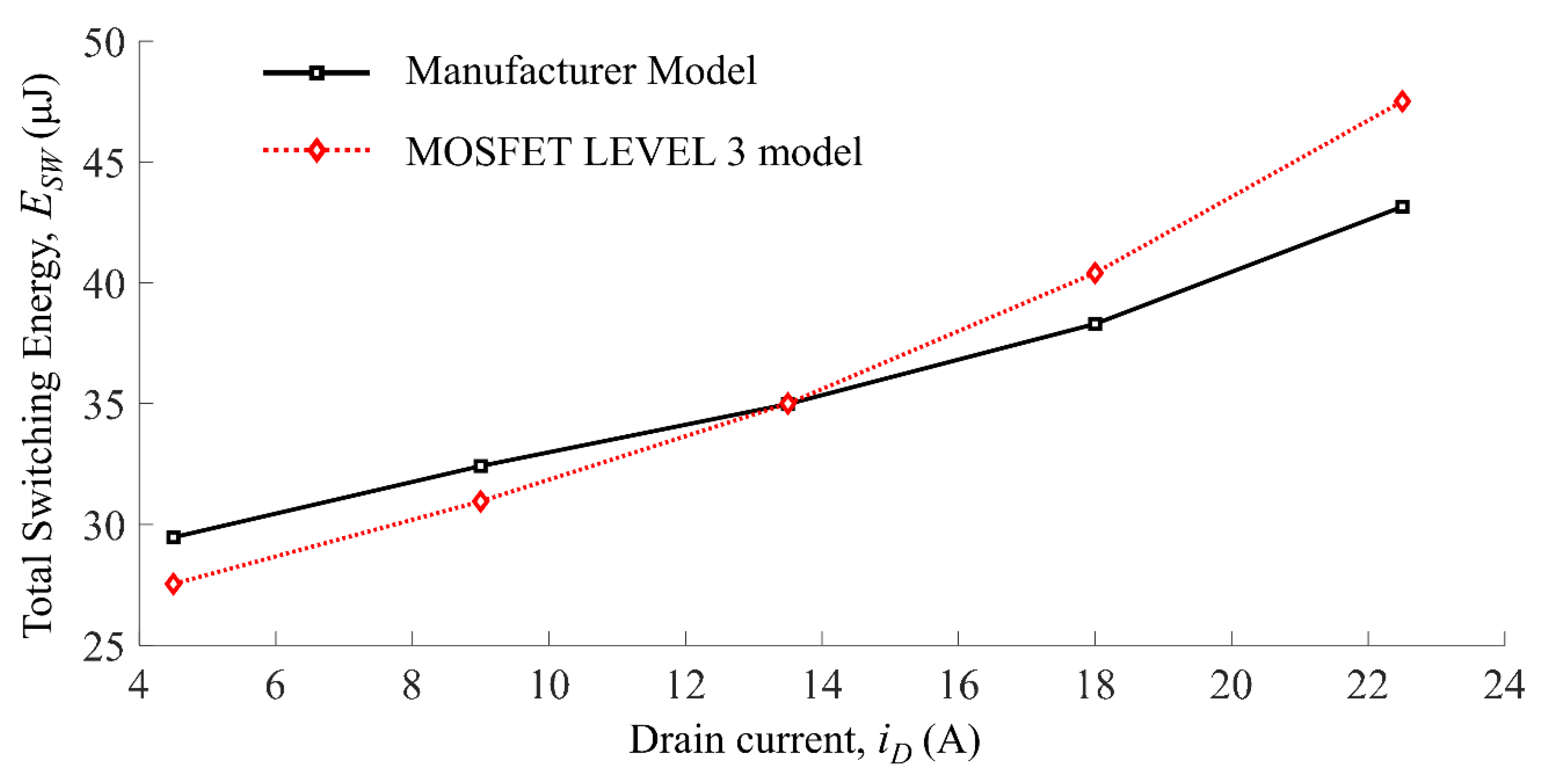
| S. No. | Parameters | Value | |
|---|---|---|---|
| Symbol | Description | ||
| 1 | VBUS | DC bus voltage | 400 V |
| 2 | ISW | Switching current | 22.5 A |
| 3 | RGON | Turn-on gate resistor | 10 Ω |
| 4 | RGOFF | Turn-off gate resistor | 2 Ω |
| 5 | VDRV_P | Turn-on gate voltage | 6 V |
| 6 | VDRV_N | Turn-off gate voltage | 2 V |
| 7 | DT | Dead time | 100 ns |
| 8 | T_ON | Turn-on period | 2 μs |
| 9 | T_P | Total period | 2.5 μs |
| 10 | L_DPT | Switching current inductance | 64 μH |
| 11 | L_GATE | Gate inductance | 1 nH |
| 12 | LS_EX | External source inductance | 10 pH |
| 13 | L_DS | Power loop inductance | 1 nH |
| Manufacturer Model | MOSFET LEVEL 3 Model | |
|---|---|---|
| EON | 35.92 μJ | 42.50 μJ |
| EOFF | 7.23 μJ | 5.05 μJ |
| ESW = EON + EOFF | 43.15 μJ | 47.55 μJ |
Publisher’s Note: MDPI stays neutral with regard to jurisdictional claims in published maps and institutional affiliations. |
© 2021 by the authors. Licensee MDPI, Basel, Switzerland. This article is an open access article distributed under the terms and conditions of the Creative Commons Attribution (CC BY) license (http://creativecommons.org/licenses/by/4.0/).
Share and Cite
Jadli, U.; Mohd-Yasin, F.; Moghadam, H.A.; Pande, P.; Chaturvedi, M.; Dimitrijev, S. Modeling Power GaN-HEMTs Using Standard MOSFET Equations and Parameters in SPICE. Electronics 2021, 10, 130. https://doi.org/10.3390/electronics10020130
Jadli U, Mohd-Yasin F, Moghadam HA, Pande P, Chaturvedi M, Dimitrijev S. Modeling Power GaN-HEMTs Using Standard MOSFET Equations and Parameters in SPICE. Electronics. 2021; 10(2):130. https://doi.org/10.3390/electronics10020130
Chicago/Turabian StyleJadli, Utkarsh, Faisal Mohd-Yasin, Hamid Amini Moghadam, Peyush Pande, Mayank Chaturvedi, and Sima Dimitrijev. 2021. "Modeling Power GaN-HEMTs Using Standard MOSFET Equations and Parameters in SPICE" Electronics 10, no. 2: 130. https://doi.org/10.3390/electronics10020130
APA StyleJadli, U., Mohd-Yasin, F., Moghadam, H. A., Pande, P., Chaturvedi, M., & Dimitrijev, S. (2021). Modeling Power GaN-HEMTs Using Standard MOSFET Equations and Parameters in SPICE. Electronics, 10(2), 130. https://doi.org/10.3390/electronics10020130








